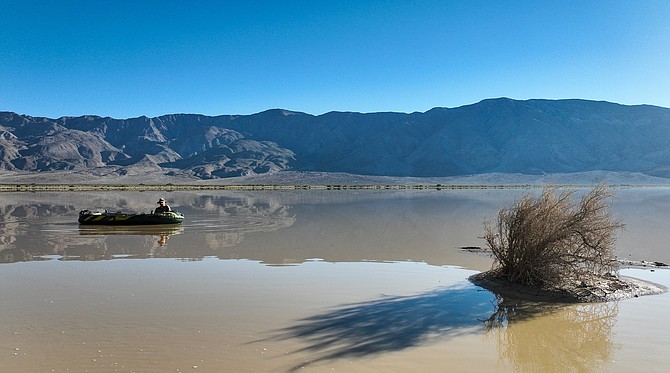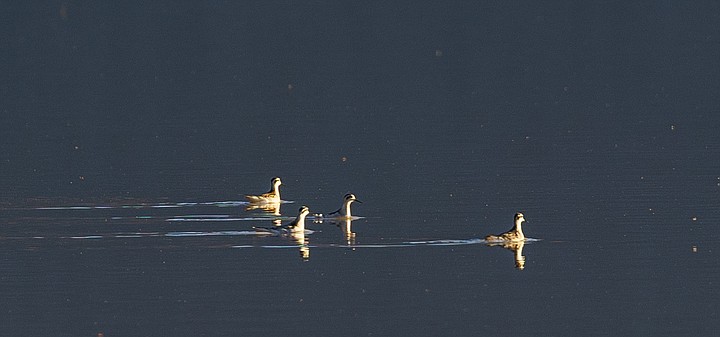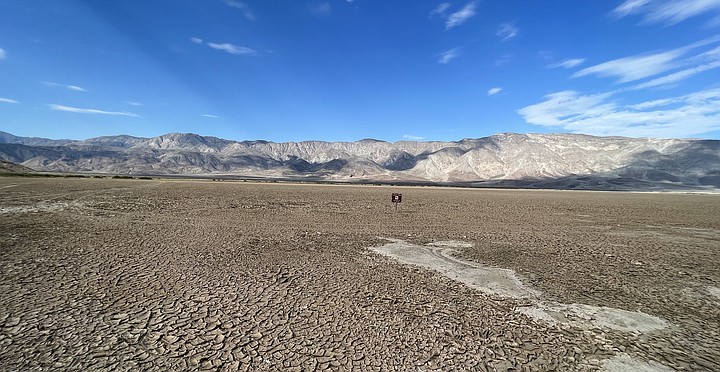 Facebook
Facebook
 X
X
 Instagram
Instagram
 TikTok
TikTok
 Youtube
Youtube

Like a ghost limb—apropos as we navigate Peg Leg Road on the way there—Clark Dry Lake haunts its shores of long ago, a mirage shimmering in the heat, recalling the presence of water in this desert place. The vast, flat expanse, stretching between steep mountains in Anza Borrego Desert State Park, is so reliably dry it was used as an airfield during and after WWII. Most of the time it looks like a desert postcard: cracked, dry, and windswept, under a blue sky, almost devoid of vegetation. But when tropical storm Hilary came to town, the deluge transformed the parched plain into a rippling body of water—harking back to ancient times.
Clark Dry Lake was once part of the massive Lake Cahuilla, 35 miles wide, 300 feet deep, and stretching 100 miles from Coachella Valley to northern Mexico, which dried up by about 1600 A.D. Its northern portion is now a reservoir in La Quinta, and an engineering snafu in 1905 refilled its middle—now the Salton Sea. Cahuilla and Kumeyaay fish traps are still visible on Lake Cahuilla’s relic shorelines throughout Riverside and San Diego counties. The Clark brothers dug a well at the dry lakebed in 1904 and found water just 9’ from the surface.
The day of the 2023 storm, August 20, Clark Dry Lake got walloped with 2.27 inches of rain in just a few hours. In the desert that’s a lot: the area got 2.9 inches for all of 2022. Plus all the surrounding mountains drain into the dry lake, and there’s no outlet for the water (like the notorious “playa” where Burning Man attendees got stuck). Retired Anza Borrego Desert State Park superintendent Mark Jorgensen said the water on the lakebed after Hilary was maybe 7-10 inches deep. It was visible from Highway S22, he said, but he didn’t get down to the shore before the water was gone.

“It went quicker than I thought,” said Jorgensen. “With the wind, and temperatures about 110 every day for more than a week, it was gone fast.” Some evaporated, some absorbed into the mud sponge that is the dry lake surface, and some percolated down to the aquifer.
Sicco Rood, who maintains weather stations throughout the park, visited six days after Hilary and said there were only 3-5 inches of water left. “I put in a blow-up raft hoping to go a bit further, but the water level was already too low for paddling.” On one rare occasion in the past ten years, when monsoonal rains brought 3-4 inches in a short time, Jorgensen and Rood saw the lake get up to two feet deep—enough for Rood to paddle his canoe out to the middle of the lake and enjoy a novel view of the desert mountains reflecting on the water’s surface.
Typical winter rainfall, less than .5 inch, doesn’t cover the whole lakebed with water. Instead the surface turns to “chocolate milk slurry,” as Jorgensen described it, pocked with vernal pools where dormant shrimp eggs come to life after years of waiting for the right conditions. In cooler months the pools might last up to a month: plenty of time for the shrimp to hatch, mate, and lay more eggs.

Rood didn’t find any shrimp after Hilary—the water didn’t last long enough. He did manage to photograph a group of red-necked phalaropes, swimming in the lake “as though it was totally normal.” Red-necked phalaropes migrate from the Arctic and some stop over or spend winter at the Salton Sea.
When shrimp do pop out in the pools, Clark Dry Lake teems with life: shorebirds, coyotes, kit foxes, badgers, raccoons, and others come out for shrimp dinner, said Jorgensen. On the menu are three species: clam shrimp, tadpole shrimp, and San Diego fairy shrimp. Fairy shrimp are endangered and have also been recorded in vernal pools in Kearny Mesa, Otay Mesa, and Miramar.
By the time we made it out to the desert, 18 days after the downpour, there was no sign of a wet lake. Clark Dry Lake was already back to its usual state, as Jorgensen said, “dried up potato chips.” If winter storms bring more than half an inch of rain, Rood said, the lake might fill up 1-2 inches and the shrimp will probably appear. And if the area gets multiple inches in a short time, canoeing in the desert could be a reality.


Like a ghost limb—apropos as we navigate Peg Leg Road on the way there—Clark Dry Lake haunts its shores of long ago, a mirage shimmering in the heat, recalling the presence of water in this desert place. The vast, flat expanse, stretching between steep mountains in Anza Borrego Desert State Park, is so reliably dry it was used as an airfield during and after WWII. Most of the time it looks like a desert postcard: cracked, dry, and windswept, under a blue sky, almost devoid of vegetation. But when tropical storm Hilary came to town, the deluge transformed the parched plain into a rippling body of water—harking back to ancient times.
Clark Dry Lake was once part of the massive Lake Cahuilla, 35 miles wide, 300 feet deep, and stretching 100 miles from Coachella Valley to northern Mexico, which dried up by about 1600 A.D. Its northern portion is now a reservoir in La Quinta, and an engineering snafu in 1905 refilled its middle—now the Salton Sea. Cahuilla and Kumeyaay fish traps are still visible on Lake Cahuilla’s relic shorelines throughout Riverside and San Diego counties. The Clark brothers dug a well at the dry lakebed in 1904 and found water just 9’ from the surface.
The day of the 2023 storm, August 20, Clark Dry Lake got walloped with 2.27 inches of rain in just a few hours. In the desert that’s a lot: the area got 2.9 inches for all of 2022. Plus all the surrounding mountains drain into the dry lake, and there’s no outlet for the water (like the notorious “playa” where Burning Man attendees got stuck). Retired Anza Borrego Desert State Park superintendent Mark Jorgensen said the water on the lakebed after Hilary was maybe 7-10 inches deep. It was visible from Highway S22, he said, but he didn’t get down to the shore before the water was gone.

“It went quicker than I thought,” said Jorgensen. “With the wind, and temperatures about 110 every day for more than a week, it was gone fast.” Some evaporated, some absorbed into the mud sponge that is the dry lake surface, and some percolated down to the aquifer.
Sicco Rood, who maintains weather stations throughout the park, visited six days after Hilary and said there were only 3-5 inches of water left. “I put in a blow-up raft hoping to go a bit further, but the water level was already too low for paddling.” On one rare occasion in the past ten years, when monsoonal rains brought 3-4 inches in a short time, Jorgensen and Rood saw the lake get up to two feet deep—enough for Rood to paddle his canoe out to the middle of the lake and enjoy a novel view of the desert mountains reflecting on the water’s surface.
Typical winter rainfall, less than .5 inch, doesn’t cover the whole lakebed with water. Instead the surface turns to “chocolate milk slurry,” as Jorgensen described it, pocked with vernal pools where dormant shrimp eggs come to life after years of waiting for the right conditions. In cooler months the pools might last up to a month: plenty of time for the shrimp to hatch, mate, and lay more eggs.

Rood didn’t find any shrimp after Hilary—the water didn’t last long enough. He did manage to photograph a group of red-necked phalaropes, swimming in the lake “as though it was totally normal.” Red-necked phalaropes migrate from the Arctic and some stop over or spend winter at the Salton Sea.
When shrimp do pop out in the pools, Clark Dry Lake teems with life: shorebirds, coyotes, kit foxes, badgers, raccoons, and others come out for shrimp dinner, said Jorgensen. On the menu are three species: clam shrimp, tadpole shrimp, and San Diego fairy shrimp. Fairy shrimp are endangered and have also been recorded in vernal pools in Kearny Mesa, Otay Mesa, and Miramar.
By the time we made it out to the desert, 18 days after the downpour, there was no sign of a wet lake. Clark Dry Lake was already back to its usual state, as Jorgensen said, “dried up potato chips.” If winter storms bring more than half an inch of rain, Rood said, the lake might fill up 1-2 inches and the shrimp will probably appear. And if the area gets multiple inches in a short time, canoeing in the desert could be a reality.
Comments